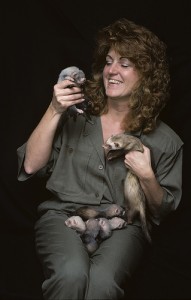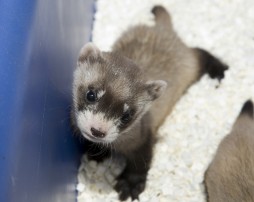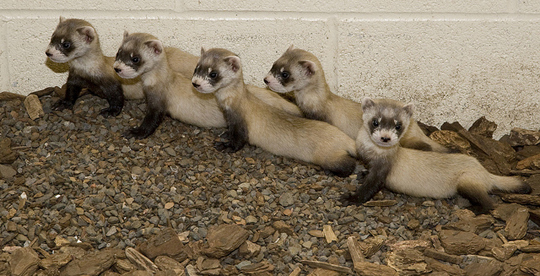Black-footed ferrets reach a conservation milestone
The black-footed ferret, once thought to be extinct in the wild, was rediscovered in 1981 with a small population of 24 animals in Wyoming―30 years later the species’ future is brighter than ever. The Smithsonian Conservation Biology Institute is marking this anniversary with a record-breaking year―50 surviving black-footed ferret kits were born at the Zoo’s Front Royal facility this year, helping to bolster the population of North America’s sole ferret species. Today more than 1,000 ferrets exist in the wild as the result of a successful reintroduction program at six breeding institutions, including SCBI. (For extensive information about SCBI’s success breeding the black-footed ferret, visit the Zoo’s black-footed ferret press kit.)
“This is truly a banner year for us,” said Dave Wildt, head of SCBI’s Center for Species Survival. “I was here and remember when the first ferrets arrived. We were unsure of ferret husbandry techniques at the time and have since developed innovative techniques to ensure their survival. Black-footed ferrets are a charismatic North American species and among the Smithsonian’s most successful conservation efforts.”
Fifty-one black-footed ferret kits were born at SCBI this year from April through June and 50 survived. All but one of the kits were born through natural breeding. A single kit was the result of artificial insemination using frozen sperm collected in 1997. The average litter size is three to four kits, and this year’s largest litter had 10 kits.

May 1, 1988. Dr. JoGayle Howard holds ferrets conceived through artificial insemination. (Photo by Jessie Cohen)
SCBI was the first institution to develop a successful laparoscopic artificial insemination technique for black-footed ferrets, which involves depositing the sperm directly into the uterus. To date, 139 kits have been produced using this method. SCBI also maintains the only genome resource bank for black-footed ferrets that preserves frozen semen from genetically valuable males, thereby extending their reproductive life. Zoo scientists use this semen for artificial insemination to maintain and enhance genetic diversity by infusing underrepresented genes into the population at strategic times.
Monday, Sept. 26, will mark the 30th anniversary of the discovery of the last 24 wild black-footed ferrets in North America. The U.S. Fish & Wildlife Service stepped in to save the dwindling population and moved the remaining ferrets into captivity between 1985 and 1987 to begin breeding them. Of these, 18 survived. SCBI was the first institution to receive offspring from the 18 ferrets in 1987 and successfully bred them in 1988. Today more than 1,000 black-footed ferrets exist in the wild―each one a descendent of the original 18 surviving individuals.
This year also marks the 20th anniversary of the first release of black-footed ferrets back into their native prairie habitat. SCBI has produced 670 black-footed ferrets, 220 of which have been released into the wild. The remaining ferrets were kept for captive breeding in subsequent years. The National Black-Footed Ferret Conservation Center in Colorado prepares black-footed ferrets for transition to the wild through preconditioning, which involves familiarizing the animals with burrows to increase their chance of survival in the wild. After they have completed the approximately 45-day process, the ferrets are then released into one of 19 specially selected sites in the western Great Plains.
To follow the Zoo’s progress in breeding and caring for black-footed ferrets, watch Rupee and her seven kits via webcam and check for news on the Zoo’s Twitter feed and Facebook page.
Posted: 6 September 2011





